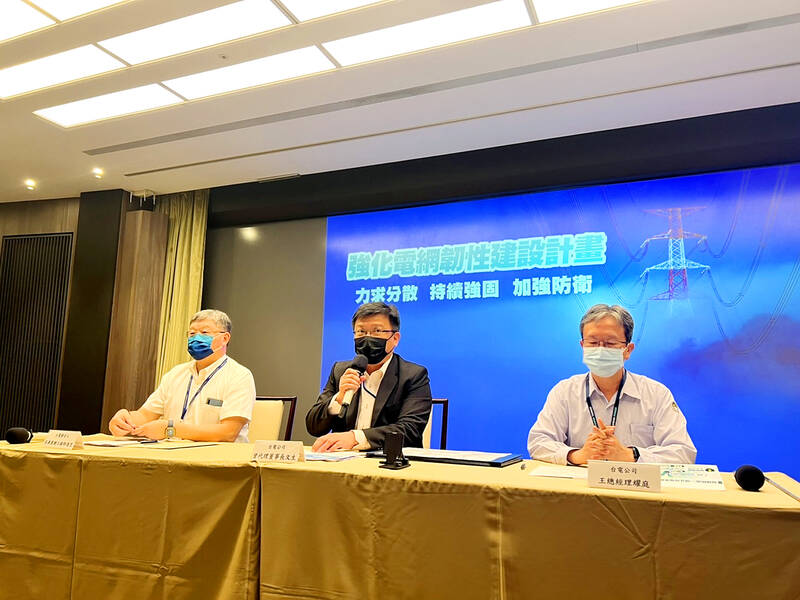Taiwan Power Co (Taipower, 台電) yesterday unveiled plans to invest NT$564.5 billion (US$18.13 billion) over the next 10 years to enhance the resilience and reliability of its power grids, in a bid to prevent massive outages from affecting industrial production and people’s lives.
The power grid enhancement plan, the largest in the company’s history, came amid growing concern about the state utility’s ability to maintain stable electricity supply after a large-scale blackout in March affected 5.49 million households and halted the operations of semiconductor, cement and petrochemical plants, mostly in Kaohsiung and adjacent areas.
That is aside from the frequent and smaller power interruptions that struck households, stores and factories over the past one to two years due to equipment malfunction or human error.

Photo: Ching Lin, Taipei Times
“The new project aims to enhance power grid resilience by deploying microgrids, rather than relying on major grids for electricity supply,” Taipower acting chairman Tseng Wen-sheng (曾文生) told a media briefing.
The multiple dispersed power generation sources and transmission channels would reduce the frequencies of major blackouts as the damage can be better controlled within a region, Taipower president Wang Yao-ting (王耀庭) said.
The large-scale outage in March was an example. The blackout was caused by a switch malfunction at Kaohsiung’s Hsinta Power Plant (興達電廠), which took the facility offline and led to a circuit malfunction at the Longqi Extra High Voltage Substation (龍崎超高壓變電所), causing several power plants in the south to shut down.
To prevent such ripple effects, Taipower plans to reduce interregional power supply by adjusting power allocation and deploying dedicated microgrids to transmit power directly to industrial users in major science parks, Wang said.
Taipower plans to transmit electricity to industrial users in the Hsinchu Science Park from the Tunghsiao Power Plant (通霄電廠) in Miaoli County, while the Taichung Power Plant (台中電廠) would serve users in the Central Taiwan Science Park.
The Hsinta Power Plant will supply power to companies in the Southeastern Taiwan Science Park, while the Datan Power Plant (大潭電廠) will be responsible for users in Taoyuan and New Taipei City industrial parks, the company said.
Those regional grids would also provide a pathway to switch to renewable energy, such as wind and solar power, Wang said.
To provide stable power supply, Taipower plans to add about 52 new and revamped substations, mostly indoor facilities within the next 10 years.
The company plans to upgrade substations and power transmission systems more regularly to boost their reliability, its said.
The Cabinet has approved a capital injection of NT$150 billion for Taipower next year to fund the project, Tseng said.

GROWING OWINGS: While Luxembourg and China swapped the top three spots, the US continued to be the largest exposure for Taiwan for the 41st consecutive quarter The US remained the largest debtor nation to Taiwan’s banking sector for the 41st consecutive quarter at the end of September, after local banks’ exposure to the US market rose more than 2 percent from three months earlier, the central bank said. Exposure to the US increased to US$198.896 billion, up US$4.026 billion, or 2.07 percent, from US$194.87 billion in the previous quarter, data released by the central bank showed on Friday. Of the increase, about US$1.4 billion came from banks’ investments in securitized products and interbank loans in the US, while another US$2.6 billion stemmed from trust assets, including mutual funds,

Micron Memory Taiwan Co (台灣美光), a subsidiary of US memorychip maker Micron Technology Inc, has been granted a NT$4.7 billion (US$149.5 million) subsidy under the Ministry of Economic Affairs A+ Corporate Innovation and R&D Enhancement program, the ministry said yesterday. The US memorychip maker’s program aims to back the development of high-performance and high-bandwidth memory chips with a total budget of NT$11.75 billion, the ministry said. Aside from the government funding, Micron is to inject the remaining investment of NT$7.06 billion as the company applied to participate the government’s Global Innovation Partnership Program to deepen technology cooperation, a ministry official told the

AI TALENT: No financial details were released about the deal, in which top Groq executives, including its CEO, would join Nvidia to help advance the technology Nvidia Corp has agreed to a licensing deal with artificial intelligence (AI) start-up Groq, furthering its investments in companies connected to the AI boom and gaining the right to add a new type of technology to its products. The world’s largest publicly traded company has paid for the right to use Groq’s technology and is to integrate its chip design into future products. Some of the start-up’s executives are leaving to join Nvidia to help with that effort, the companies said. Groq would continue as an independent company with a new chief executive, it said on Wednesday in a post on its Web

Taiwan Semiconductor Manufacturing Co (TSMC, 台積電), the world’s leading advanced chipmaker, officially began volume production of its 2-nanometer chips in the fourth quarter of this year, according to a recent update on the company’s Web site. The low-key announcement confirms that TSMC, the go-to chipmaker for artificial intelligence (AI) hardware providers Nvidia Corp and iPhone maker Apple Inc, met its original roadmap for the next-generation technology. Production is currently centered at Fab 22 in Kaohsiung, utilizing the company’s first-generation nanosheet transistor technology. The new architecture achieves “full-node strides in performance and power consumption,” TSMC said. The company described the 2nm process as